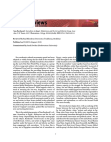The Surrealist Movement in Egypt in the 1930s and the 1940s
Ondřej Beránek
Introduction
In the past decade, the
crisis concerning types of literary self-expression has made the latest
generation of Egyptian artists turn to the past to look for new sources
of inspiration. Among other things, these artists have discovered their
heritage in the Surrealist movement. The basic feature of this revived interest
was the publishing of reprints of the most important books written by prominent
members of the Egyptian Surrealist group called
al-Fann wa’l-ḥurrīya (Art and Liberty),
which was founded in Cairo thanks to the initiative of Georges Hénein, the
leadinG Egyptian poet and Surrealism theorist.
It should be noted that this event was accompanied by a “suspicious silence”1
on the part of country’s best critics and contemporary Egyptian literature
historians. After 1946, another group, La part du sable ,continued the group’s
cultural activities. Anwar Kāmil (1913-1991), one of thefounders of the Art and
Liberty group and the editor-in-chief of its Arabic review,at-Taṭ awwur (Evolution)
should be credited for this revival of Cairo heritage. It was his contribution
that made it possible to publish, between 1987 and 1991 and in a limited print
run, a range of important Egyptian Surrealist works.This paper attempts to
depict the genesis and the main features of the Surrealist movement in Egypt and
will be primarily concerned with the movement’s heyday during the 1930s and
1940s. It is beyond the reasonable scope of this paper to give a complete
historical and aesthetic analysis of Egyptian Surrealism. Instead,emphasis will
be placed on the examination of the basic trends in its evolution.
The organization of the article therefore follows the development of the main
features of Egyptian Surrealism. Consequently one may ask to what extent it is
possible to transfer certain art forms that
were created under specific artistic,and above all historical,
conditions to a cultural environment that is markedly different.The
Surrealist group in Egypt, one of the most active in the world, was
officially established on January 9, 1939, sixteen years after the publishing of
the first Surrealist manifesto in Paris. Georges Hénein played an important part
in the process; during his studies in France he got acquainted with the key
representatives of Surrealism and he and André Breton, the Pope of Surrealism,
even became friends. Besides Hénein, other people were important participants in
creating the Egyptian group,namely Ramsīs Yūnān, Fu’ād Kāmil, and Kāmil
at-Tilimsānī, all of whom were distinguished painters as well as writers. Hénein coordinated the Egyptian
activities with the French group and other groups in the world, including
Belgium, Great Britain, and the USA. The Egyptian Surrealist movement flourished during the first five years of its existence. The period 1940-1945 saw five Surrealist exhibitions in
Cairo under the common label Macāriḍ al-fann al-ḥurr (The
Exhibitions of the Free Art), where the Egyptian Surrealists tried to articulate
all their theoretical concepts.













